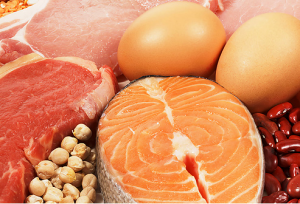 It is vital our diets contain protein, either from animal or plant sources. Proteins are often called the ‘building blocks’ of the body, responsible for growth and repair.
It is vital our diets contain protein, either from animal or plant sources. Proteins are often called the ‘building blocks’ of the body, responsible for growth and repair.
Combinations of structures called amino acids combine in different ways to make muscles, bone, tendons, skin, hair, and other tissues. There are 10,000 different proteins in the body!
Regular protein intake is crucial because it doesn’t store in the body very easily. Adequate amounts of various protein sources should be consumed, such as complete proteins. Complete proteins contain 8 essential amino acids, mainly coming from animal products such as meat, fish, and eggs. Incomplete protein comes from sources like vegetables, fruit and nuts; these lack one or more essential amino acid.
Meat sources are not only high in protein but also iron, zinc and b vitamins. Iron is vital to good health, as well as preventing non-anaemic iron deficiency in athletes (especially women). Red meat contains more iron than most foods, and it is more easily utilised by the body than from vegetable sources. Iron helps to generate red blood cells, which carries oxygen from the lungs to the tissues and carbon dioxide back to the lungs. Red meat is also a good source of other vitamins and minerals such as phosphorus, potassium, magnesium and selenium.
Zinc is particularly important for a healthy immune system, essential for athletes training hard. While other foods such as milk and lentils contain zinc, red meat is the most efficient way of getting it into your body. Red meat is also one of the best sources for b vitamins, which help to maintain nerve cells and normal blood formation.
Foods containing protein:
• Meat, poultry, fish, shellfish and eggs
• Pulses, nuts and seeds
• Soya products and vegetable protein foods
Healthy Ways to Cook Meat
Firstly, when buying your protein make sure you always:
1. Choose lean cuts where possible, or trim visible fat from meat before cooking.
2. If you can, go for lower-fat versions of meat products.
Lean beef, like sirloin and lower-fat pork, like tenderloin, can be the focus of a healthy dinner, as long as you don’t add extra high calorie sauces.
It is also important to cook your meat with healthy preparation methods. Here are some of the healthier ways to cook meat:
Grilling
Grilled foods can be lower in saturated fat as long as you make sure the fat can drip away. To cut down on fat, grill without any fat or oil. Grilled meat should look seared, faintly charred edge with the rest of the meat being very tender and succulent. Remember to try and position the meat 2-3 inches from the heat, turning the meat over halfway through to grill the other side. Never season meat before grilling, as salt draws out the juices you’re trying to keep in.
Oven Cook/Roasting
This method is suitable for cooking all types of protein. Poultry that is cooked without the skin and fish that is very low-fat would be best cooked in a type of broth and covered, while chicken that might have skin on them or a more fatty fish, like a salmon could be cooked uncovered.
Braising is a method of cooking in the oven. The food is cooked in liquid in a covered pan; it is a combination of stewing and pot roasting.
Poaching
This is a very healthy cooking method, involving covering food in a small amount of liquid that is brought to a simmer, rather than a boil. Use a covered cooking pan or large pot; it keeps whatever protein you cook very moist.
Eggs and fish are perfect for poaching. This method is cooking is virtually fat-free, given that water or a broth is used. You would then usually remove the food from the liquid, which can be discarded.
Stir Frying
This is one of the quickest ways to cook so all your ingredients need to be ready before you start. Pre-heat the frying pan on medium to high heat for at least a minute before adding oil (or skip this step if you have a non-stick pan). Add small amount of oil, extra virgin olive or canola oil are great heart-healthy choices. Cook the meat first and then set it aside, this is so you do not overcook it and other ingredients keep their individual flavours.
Cook the meat at medium-high heat ensuring to wait a few seconds before tossing; this is so that it has a chance to brown. Remember to adjust the temperature as needed to prevent the meat from burning. Sautéing is very similar to stir frying. It is a form of dry-heat cooking that uses a very hot pan and a small amount of fat to quickly cook food while browning the surface.
Recommendations and Related Health Risks
The current recommended dietary allowance (RDA) for protein is 0.8g per kg of body weight (BW), although it is commonly advised to increase this for athletes.
• Endurance: 1.2-1.4g per kg of BW
• Ultra-endurance: ≥1.2-1.4g per kg of BW
• Strength trained athletes: 1.2-1.7g per kg of BW
Current literature suggests protein recommendations are not that straightforward and depend upon numerous factors, such as type of protein and timing in relation to other nutrients.
 With regards to red meat The Food Standards Agency (FSA) does not specify a ‘safe’ recommendation figure. However, you should eat in moderation and try to choose leaner cuts where possible. The British Nutrition Foundation (BNF), recommends consuming no more than 90g cooked red meat per day, as part of a balanced and varied diet. The World Cancer Research Fund advises that people should eat no more than 80g red meat a day for health reasons.
With regards to red meat The Food Standards Agency (FSA) does not specify a ‘safe’ recommendation figure. However, you should eat in moderation and try to choose leaner cuts where possible. The British Nutrition Foundation (BNF), recommends consuming no more than 90g cooked red meat per day, as part of a balanced and varied diet. The World Cancer Research Fund advises that people should eat no more than 80g red meat a day for health reasons.
The FSA have also investigated into the safety of red meat after research suggested that beef, lamb and pork are the cause of one in six outbreaks of food poisoning; although, most cases are likely to be linked to poor hygiene in the home. Cooking meats at high temperature methods, such as frying or grilling directly over an open flame, form the chemicals heterocyclic amines (HCAs) and polycyclic aromatic hydrocarbons (PAHs).
Even though no specific guidelines for HCA/PAH consumption exist, you can reduce their exposure by using several cooking methods:
• Avoid direct exposure of meat to an open flame, such as barbequing, or a hot metal surface and avoiding prolonged cooking times (especially at high temperatures).
• Use a microwave oven to cook meat before any exposure to high temperatures can also considerably reduce HCA formation by reducing the time that meat must be in contact with high heat.
• Continuously turning meat over on a high heat source can significantly reduce HCA formation compared with just leaving the meat on the heat source.
• Removing charred meat and avoiding from using gravy made from meat drippings can also reduce HCA and PAH exposure.
Protein Supplementation
 Protein has been considered a vital nutrient for years, making protein supplementation a very successful industry. Powdered protein sources or protein bars, containing whey are digested rapidly. Where as, casein protein is digested slower because it promotes a slower rise in plasma amino acids, and does not stimulate protein synthesis.
Protein has been considered a vital nutrient for years, making protein supplementation a very successful industry. Powdered protein sources or protein bars, containing whey are digested rapidly. Where as, casein protein is digested slower because it promotes a slower rise in plasma amino acids, and does not stimulate protein synthesis.
Although these sources are widely used in the sporting industry, protein and amino acid supplementation has not been proven to positively affect athletic performance.
Therefore recommendations regarding protein supplementation are basic and directed at aiding the training response to, and the recovery period after exercise.
There are various types of protein sources used in products on the market, such as whey, casein, milk, soya, egg, pea and colostrum. Two of the most popular proteins used are whey and casein.
Whey protein
Whey protein is a quickly digested protein, making it ideal to use during and after exercise. Whey is highly bio-available, and has the highest biological value of any protein source. It has been shown to be more effective than casein protein in stimulating muscle protein synthesis, when provided immediately after exercise. This is thought to be related to differences in amino acid composition, for example, greater concentrations in whey than casein, and differences in digestive properties. Read more here.
Casein protein
Casein protein is slowly absorbed from the stomach and small intestine so the blood amino acid levels do not increase as rapidly as whey. This meaning, the slow absorption will help maintain the increased amino acid levels over a longer period of time. It is best to consume casein at night to feed the body while sleeping; it also has properties that help prevent muscle depletion. Read more here.
The Vegetarian Athlete
With the growing interest in the potential health benefits of plant-based diets, it is interesting to consider whether vegetarian diets could influence athletic performance. Former England international Paul Sampson gave up meat and became a pescatarian (a vegetarian who occasionally eats fish).
Paul believed his new diet gave him more energy and improved his performance on the pitch.
This said, most nutritionists are still unconvinced of the benefits of a vegetarian diet for elite sportspeople. While it can mean a diet low in saturated fat, which is good, it requires athletes to be more vigilant about their intake of protein, iron and vitamin B12.
Long-term studies assessing the effects of vegetarian diets on athletes have not been conducted but from other studies the following comments can be made:
1) Well-planned, appropriately supplemented vegetarian diets appear to effectively support athletic performance.
2) Vegetarian protein intakes are adequate to meet needs for total nitrogen and the essential amino acids, providing support to athletic training and performance.
3) Vegetarians (particularly women) are at increased risk for non-anaemic iron deficiency, which may limit endurance performance.
4) As a group, vegetarians have lower muscle creatine concentrations. They are likely to experience greater performance improvements after creatine loading in activities that rely on the adenosine triphosphate/phosphocreatine system.
5) Coaches and trainers should be aware that some athletes may want to take on a vegetarian diet for weight control. Therefore, is it essential to investigate this to prevent any disordered eating patterns.








 When most people hear the word “Peloton” they think of an expensive black bike with shiny red buttons and that controversial commercial where the husband gifted his wife a Peloton for Christmas.
When most people hear the word “Peloton” they think of an expensive black bike with shiny red buttons and that controversial commercial where the husband gifted his wife a Peloton for Christmas. If the app interests you, Peloton is currently offering a 30 day FREE TRIAL, so why not give it a try? Check it out
If the app interests you, Peloton is currently offering a 30 day FREE TRIAL, so why not give it a try? Check it out 

 This article would not be complete, however, if we did not acknowledge some of the delivery issues that have been plaguing Peloton over the last year. Most of the delivery issues seem to affect U.S. deliveries, however, the UK deliveries have been affected as well.
This article would not be complete, however, if we did not acknowledge some of the delivery issues that have been plaguing Peloton over the last year. Most of the delivery issues seem to affect U.S. deliveries, however, the UK deliveries have been affected as well.







